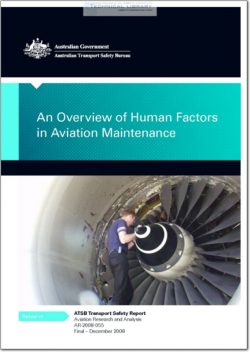ATSB-AR-2008-055

- Version
- 104 Downloads
- 1.60 MB File Size
- 1 File Count
- August 9, 2016 Create Date
- August 9, 2016 Last Updated
An Overview of Human Factors in Aviation Maintenance

Without the intervention of maintenance personnel, equipment used in complex
technological systems such as aviation, rail and marine transport, and medicine
would drift towards a level of unreliability that would rapidly threaten efficiency
and safety.
Despite the essential contribution of maintenance to system reliability, maintenance
is also a major cause of system failure. The rate of power station outages increases
shortly after maintenance, maintenance quality is a major concern in the chemical
industry, and in aviation there is evidence that maintenance is contributing to an
increasing proportion of accidents.1 As automated systems become increasingly
common, humans are performing less direct manual control of equipment and
systems. As a result, maintenance is becoming a major remaining point of direct
interaction between people and technology, where human capabilities and
limitations can have a significant impact on system safety and reliability.
Understanding the human factors in maintenance is more necessary than ever if we
are to improve safety and reliability in aviation.
Modern technological systems in industries such as manufacturing, transport and
healthcare comprise equipment, procedures, and of course people. In most cases,
we have a fairly good understanding of the performance characteristics of the
engineered equipment that form parts of these systems. Aircraft come with manuals
that specify their performance envelopes and capabilities. Procedures too, have
been created by people and can be documented and understood. But when it comes
to people, we are faced with a system element that comes with no operating manual
and no performance specifications, and that occasionally performs in ways not
anticipated by the system designers. Some of these failures can be easily explained,
an arithmetic error for example, while others are harder to predict. Although
individuals differ, researchers have discovered general principles of human
performance that can help us to create safer and more efficient systems. The focus
of this paper is on the functioning of people as elements of maintenance systems in
av1at10n.
| File | Action |
|---|---|
| ATSB-AR-2008-055 An Overview of Human Factors in Aviation Maintenance.pdf | Download |
Comment On This Post